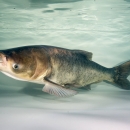Featured Species
The Whitney Genetics Laboratory works on detection of invasive species invasive species
An invasive species is any plant or animal that has spread or been introduced into a new area where they are, or could, cause harm to the environment, economy, or human, animal, or plant health. Their unwelcome presence can destroy ecosystems and cost millions of dollars.
Learn more about invasive species including the highly invasive bighead and silver carp, and the potentially damaging black and grass carp. The lab has also been working with other U.S. Fish and Wildlife Service offices to develop new eDNA monitoring tools for other Great Lakes aquatic invasive species such as red swamp crayfish and bloody red shrimp. In addition, the lab works on sensitive species such as the eastern hellbender, Ozark cavefish and Topeka shiner.




